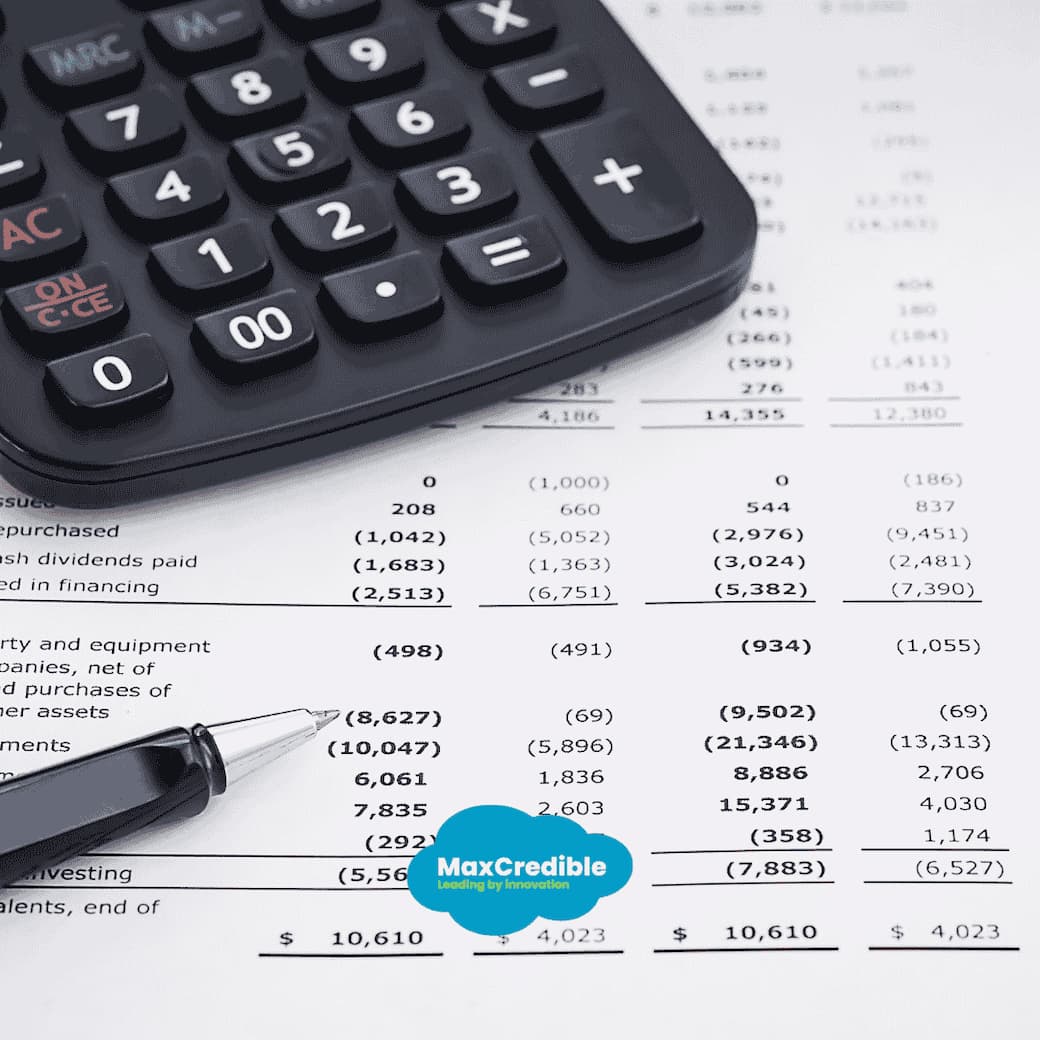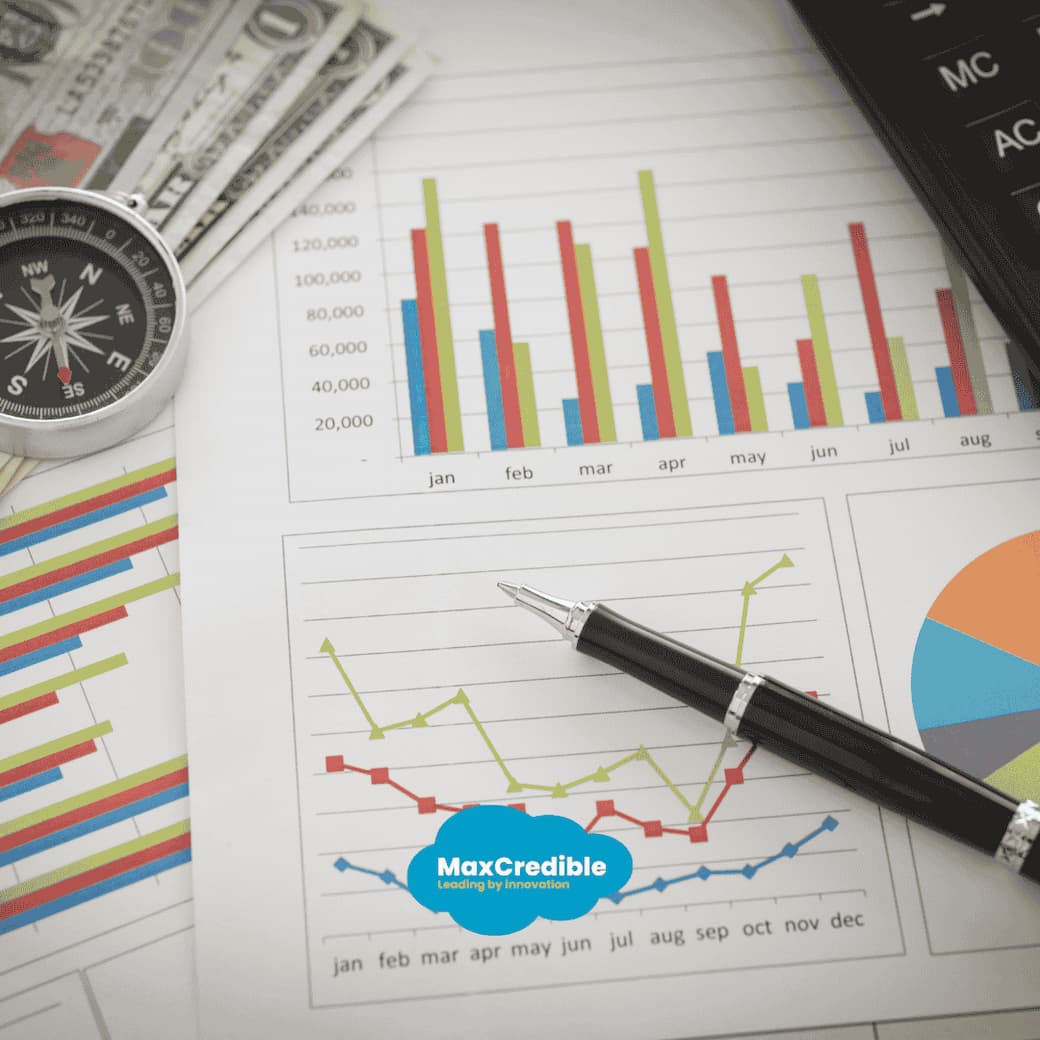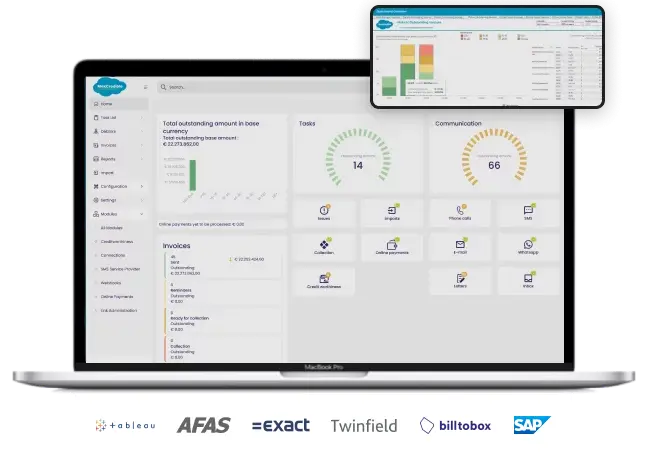Lower your average accounts receivable balance and improve your cash flow
A low accounts receivable balance benefits your organization. High outstanding invoices put pressure on cash flow. Late payments and inefficient processes inhibit your business growth and increase financial risks.
How do you solve this? By automating accounts receivable management. Automated payment reminders help you reduce the debtor balance. Payments come in faster, your cash flow becomes more stable and processes run more efficiently.
Automation is not difficult if the right steps are followed. You do this with a structured roadmap. In this blog, you will discover how to take these steps and what the benefits are. Improve your financial processes today and strengthen your organization.
This article in 30 seconds
- A low average accounts receivable balance means that payments come in quickly. This gives your business financial stability and room for investment in growth.
- When payments are delayed, you have less cash available. This hinders investments in growth and causes supplier bills not to be paid on time.
- Through automation of accounts receivable management, payment reminders are sent timely and consistently.
- With a healthy debtor balance, you have little financial risk and increase your stability.
- Debtors are customers who have yet to pay outstanding invoices. The accounts receivable balance is the total amount of these payments at a specific time.
- A high accounts receivable balance often indicates inefficient receivables management. Invoices that go unpaid for a long time contribute to this. This often occurs due to inconsistent follow-up of manual processes.
- Use a simple formula to calculate your average accounts receivable balance.
- Use the formula: (Beginning Debtors + Ending Debtors) / 2..
- Calculate your average debtor term using the following formula:
- (Accounts Receivable Balance ÷ Annual Sales) x 365 days.
- Long accounts receivable terms put pressure on your cash flow and working capital. When customers wait a long time to pay outstanding invoices, liquidity problems arise.
- Clear payment terms and automated reminders ensure faster payments. This lowers the average payment terms of your debtors, improving cash flow and reducing risk for your organization.
- Errors such as missed reminders or incomplete data create inefficient accounts receivable management. Automation offers a more efficient and reliable solution.
- MaxCredible offers flexible communication options. With MaxCredible, you communicate through different communication channels. This way, disputes are handled faster. This speeds up the payment cycle.
- You can communicate via WhatsApp, text, email, phone or letters, tailored to your customer’s needs.
- Tableau Reporting provides real-time insight into your financial processes. With in-depth analysis, you can see where processes are stagnant and how to improve communication with your customer, with the goal of getting paid on time.
- MaxCredible easily interfaces with systems such as Exact, Twinfield and AFAS. This makes your workflow smoother and your data more reliable.
- MaxCredible saves up to 80% of your time and gets invoices paid up to 50% faster. Take advantage of the benefits today. See first, then believe? Try MaxCredible’s credit management software today 7 days free off, or request a free demo:
- ☎️ +31 (0)20 344 9070
- 📧 or e-mail to: servicedesk@maxcredible.com
What is the average debtor balance and why is it important?
The average debtor balance provides insight into the total value of outstanding invoices with your customers. It is an important financial KPI that directly affects the cash flow, liquidity and the overall financial health of your organization.
Companies therefore like to have low accounts receivable balances. After all, this means that payments come in quickly. The result? More financial stability and room to invest in growth.
A high average accounts receivable balance has a direct impact on your cash flow management and operational liquidity. Dit leidt tot vertragingen bij het betalen van leveranciers of het uitvoeren van noodzakelijke investeringen. Ook het beheren van dagelijkse bedrijfsuitgaven wordt lastiger. Door uw debiteurenbeheer efficiënt in te richten, betalen uw klanten sneller. Hiermee wordt uw DSO (Days Sales Outstanding) verlaagd, waardoor u uw werkkapitaal efficiënter inzet. Tevens voorkomt u dat er financiële tekorten ontstaan door te laat betaalde facturen.
What does debtor balance mean?
Debtors are customers who have yet to pay your invoices for products or services delivered. The debtor balance is the sum of these outstanding payments at any given time. This balance provides insight into how effective your accounts receivable management is. Does the balance remain high? Then this indicates an inefficient process or a long average payment period. Time for change, in other words.
What affects your cash flow?
- Customers who pay structurally late.
- Unresolved disputes.
- Insufficient understanding of average payment terms of debtors.
- Manual processes that cause delays in invoice processing.
What are the risks of a high accounts receivable balance?
Doubtful debtors create a high accounts receivable balance. These debtors are customers whose payment becomes uncertain or problematic. The result is financial instability, or perhaps even limited growth of your organization.
Key risks:
- Increased credit risks.: Your company lends money to customers without certainty of payment, so to speak.
- Limited scalability: When resources are tied up in outstanding invoices, less liquidity remains for growth.
- Poor customer relations: Inefficient follow-up can cause customer frustration and make communication difficult.
With the right strategies and automation, such as automated payment reminders, strengthens your organization’s financial resilience. Efficient accounts receivable management is thus not just a matter of administrative simplicity.
Want to learn more about setting up efficient accounts receivable? You’ll find out in our blog post on accounts receivable administration >
Calculating average accounts receivable balance: how do you do it?
The average accounts receivable balance shows how much your customers still have to pay on average. This is an important indicator of how healthy your accounts receivable management is. Fortunately, calculating it is not complicated.
The formula to calculate the average debtor balance
To calculate the average debtor balance, use this formula:
Average debtor balance = (Beginning debtor balance + Ending debtor balance) / 2
- Beginning Debtor Balance.: The amount of outstanding invoices at the beginning of the period.
- Closing Debtor Balance.: The amount of outstanding invoices at the end of the period.
These figures can be found in your financial records.
Do you want to calculate the average accounts receivable period? Then you need the total turnover in a given period. Then you take the average debtor balance in a year, divided by this turnover. You multiply this amount by 365 days.
Average debtor term = (Debtor Balance ÷ Annual Sales) x 365 days.
Example of calculating average debtor balance
Suppose the outstanding invoices at the beginning of a quarter total €50,000. At the end of the period, they total €70,000. Then you calculate the average balance like this:
(50.000 + 70.000) / 2 = € 60.000
This means that, on average, your customers had €60,000 in outstanding invoices that quarter.
What does this mean for your business?
A high accounts receivable balance is a warning sign. It shows that payments are overdue, putting pressure on cash flow.
What can you do if your accounts receivable balance is too high?
- Send timely payment reminders: Automation can save a lot of time here.
- Agree on shorter payment terms: This speeds up payment.
- Keep an eye on the debtor balance.: Use reports to monitor payment behavior and take quick action.
By regularly calculating and monitoring your accounts receivable balance and average payment terms, you get a grip on your accounts receivable. This keeps your cash flow stable and your organization financially healthy.
The impact of debtor terms on your business
The time customers take to pay is called the debtor period mentioned. The longer this average payment period of your debtors, the more pressure there will be on your cash flow. Reducing debtor terms is therefore an important step in effective debtor management, as it means that your debtors will more quickly pay the pay invoices.
What is the debtor term?
The debtor term is the average time customers take to pay their invoices. The debtor term is usually expressed in terms of days. Het verkorten van de termijn houdt in dat betalingen sneller binnenkomen, wat uw cashflow verbetert. Het verkorten van de tijd die klanten nodig hebben om pay invoices, strengthens your financial position.
Consequences of a long average payment period
Long payment terms put considerable pressure on your business. Long credit terms (accounts receivable) lead to increased financial risks:
- Delayed cash flow: Longer terms create a gap between income and expenses, which puts direct pressure on your working capital.
- Higher credit risks.: Customers who wait longer to pay are more likely to become defaulters.
- Stunted growth: Less available working capital means less room for investment and growth.
Example: Suppose your average payment period is 60 days, while your suppliers must be paid within 30 days. This difference can make it difficult for you to meet your own payment obligations.
How do I shorten the debtor term?
- Clear agreements: Make clear agreements on payment terms and communicate them to customers.
- Automation: Use automated payment reminders to remind customers of outstanding invoices on time.
- Predictive analytics: Analyze trends in payment behavior to identify possible customer payment problems faster.
Short accounts receivable terms are not only better for your cash flow, but also help reduce financial risks. By actively managing this, you strengthen your organization’s financial stability and create room to invest in growth.
The pitfalls of traditional accounts receivable management
Traditional accounts receivable management carries many risks. It is inefficient, error-prone and hampers your organization’s ability to gain up-to-date insights. This makes it difficult to respond quickly to problems and opportunities.
Limitations of manual processes
Manual processes are time-consuming and increase the risk for errors. Think of incorrectly entered data or missed payment reminders. This can lead to delays in payments, cluttered administration and higher costs.
Typical problems with manual processes:
- Payment reminders sent late or not at all.
- Lack of centralized data: each team works with its own lists and versions.
- Difficulty recognizing trends or risks due to lack of real-time insight.
Risks for larger companies
As your business grows, the challenges increase. More invoices, large amounts and complex processes make manual accounts receivable management untenable. Using outdated methods causes data to become fragmented and decisions to be based on incomplete or outdated information.
Automated payment reminders: what benefits does MaxCredible offer?
Efficient accounts receivable management starts with the right tools, and MaxCredible delivers just that. Imagine less manual work, faster paid invoices, and customers who stay happy. MaxCredible not only automates your processes, but also improves your results. What makes us unique? Discover the benefits for yourself!
Receive payments quickly with complaint management
Objections to an invoice, or complaints/disputes regarding an invoice? No stress. MaxCredible gets them resolved quickly. MaxCredible’s dispute management takes the delay out of the process. No more endless discussions, but a direct solution that ensures faster payments, less risk and happy customers.
Why complaint management?
- Reduced risk of defaults.
- Instant insight into problems and actions and how they are resolved.
- Higher satisfaction among both customers and your team.
Flexible communication that suits your customer
At MaxCredible, we are all about efficiency. We understand that every customer is different. That’s why you tailor your communication and payment options perfectly to what they like.
- Communication tools? WhatsApp, text, email, phone or even a letter-you choose!
- Payment options? Support for multiple payment service providers so customers pay easily with a payment link.
- Tone? A clear, consistent tone of voice that builds trust and aligns with your organization.
Result? Faster payments and strong customer relationships.
Tableau Reporting: insight that works
Get a grip on your numbers with Tableau Reporting. Geen giswerk, maar concrete data waarmee u slimme beslissingen neemt. Zie in één oogopslag waar uw processen haperen en los ze direct op. Denk aan fouten in factuurdata of risicovolle klantrelaties en efficientie van de debiteurenafdeling.
What does this yield?
- More efficient processes.
- Better cash flow forecasting.
- Strategic improvements based on facts.
Seamless integrations with your systems
Do you already have systems such as Exact, Twinfield or AFAS? Perfect!!! MaxCredible connects to these effortlessly. Our integration is plug-and-play. In other words: you establish the link very easily and within 30 minutes. Then you can get started right away.
How does this benefit your business?
- 80% less time spent on manual processes. That means more time for what really matters.
- 50% faster invoice payments. Your cash flow becomes more stable and you have more room to invest in growth.
And did you know that after purchasing MaxCredible’s credit management software, you will be up and running within 60 minutes?
Ready to make a difference? Contact us today or try MaxCredible for free. Let us help you take your accounts receivable management to the next level!
Frequently asked questions about the average debtor balance
What is the average debtor balance?
The average accounts receivable balance is the average value of outstanding receivables a company has during a given period.
How do you calculate the average debtor balance?
You calculate it by adding the beginning and ending balances of accounts receivable and dividing by two.
Why is the average debtor balance important?
It provides insight into how effectively your company manages outstanding invoices.
How does the average accounts receivable balance affect a company’s liquidity?
A high average accounts receivable balance can indicate slow payments from your debtors, putting pressure on your company’s liquidity and cash flow.
What is a healthy average debtor balance?
It depends on the industry and payment terms, but a lower balance usually indicates more efficient receivables management.
What role does the average debtor balance play in the DSO calculation?
The average accounts receivable balance is a core component in the calculation of Days Sales Outstanding (DSO), which provides insight into how quickly customers pay.
How can you reduce the average debtor balance?
Reduce debtor balances by enforcing stricter payment terms, sending timely reminders and using collection tools.
What are the risks of a high average debtor balance?
A high balance can indicate poor customer payment behavior, which can lead to cash flow problems and higher credit risks.
How often should you monitor the average debtor balance?
It is advisable to monitor this daily or weekly to identify problems in time.
What does a change in average accounts receivable balance say about your operations?
An increasing balance may indicate increasing payment delays, while a decreasing balance indicates improved receivables management processes.






